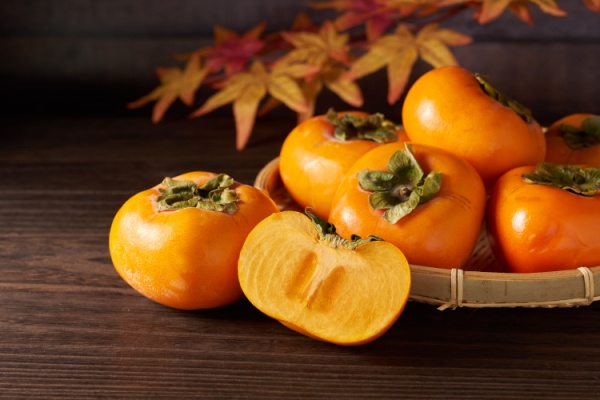Fall is persimmon season, so that naturally makes October the perfect time to have National Persimmon Month!
The long and Fruity Origins of Persimmons
Persimmons grow in temperate to tropical climates. Cultivation of Diospyros kaki began thousands of years ago in China and about 1,300 years ago in Japan. It seems to be the only edible member of the Ebenaceae family, the other well-known member of which is ebony wood. From 1870 to 1920, Japanese and Chinese cultivars were introduced to California by the USDA. They were once grown in the American Gulf States, but now only grown commercially in California’s San Joaquin Valley. The Hachiya, a vigorous cultivar, is the largest one grown in California, followed by the Fuyu, which requires pollination to increase yield and improve color. Today, the major producers are China (with 66% of world production), Japan, Brazil, Korea and Italy. Other producers include Israel, U.S., New Zealand, Australia, Spain, Georgia, Egypt and Chile [source].
Health Benefits of Persimmons
Persimmons are rich in vitamins, minerals, and antioxidants, which each provide important health benefits. For example, vitamin C helps support the immune system and protect against heart disease.
They are a good source of vitamins A and C as well as manganese, which helps the blood to clot. They also have other antioxidants, which help reduce the risk of many serious health conditions including cancer and stroke. Persimmons are also high in soluble dietary fiber, which slows the digestion of carbohydrates, preventing spikes in blood sugar. Plus, that tannin-rich fiber has proven to be particularly effective in treating high cholesterol.
Because of all of that (more than half the recommended daily intake) of Vitamin A, persimmons can help you keep eyes healthy. In addition, persimmon peel is rich in lutein, which is known to help protect against eye disease.
Some people aren’t really clear as to whether they should eat a persimmon with or without the skin. Treat a persimmon like an apple, which means, cut it up and eat the peel! The peel of a persimmon contains flavenoids that have proven to have antidiabetic and antioxidant properties. They protect against the formation of advanced glycation end products (AGEs), harmful compounds that form when protein or fat combines with sugar in the blood. AGEs have been linked to both the onset of diabetes and to long-term health complications resulting from the disease.
Nutrients per Serving
One serving (about one medium) of persimmons contains approximately:
- Calories: 118
- Protein: 1 gram
- Fat: 0 grams
- Carbohydrates: 31 grams
- Fiber: 6 grams
- Sugars: 21 grams
How to Eat Persimmons
Here are some ways to add persimmons to your diet.
- Eat them on their own like an apple. (Make sure you get the Fuyu or Sweet Pumpkin variety, as the others are highly tannic and will make your mouth pucker. You can easily tell the edible variety – they’re the ones that look like mini pumpkins, wider with a flat bottom. The ones that are longer with the pointy end are more astringent.)
- Add sliced persimmon to salads (substitute them for tomatoes).
- Use instead of apples in pork dishes.
- Bake healthy muffins, cookies, or quick breads.
- Add to oatmeal, granola, or yogurt.
- Roast persimmons for a healthy dessert.
- Sautee in butter as a topping for ice cream.
Did you know…?
According to weather folklore, persimmon seeds can tell what the weather forecast will bring in the Winter. Gardeners and farmers like to gather persimmons from their trees and cut into their seeds to learn their weather prediction. Upon slicing the seeds in half, the white kernel inside reveals one of three shapes: a spoon, fork or knife. If the seed yields a spoon shape, legend says you can anticipate a season full of snow. A fork shape means you can expect a mostly mild Winter with some light snow, and a knife shape suggests a frigid Winter with icy winds.
—
Photo Credit: manbo-photo / Shutterstock.com
